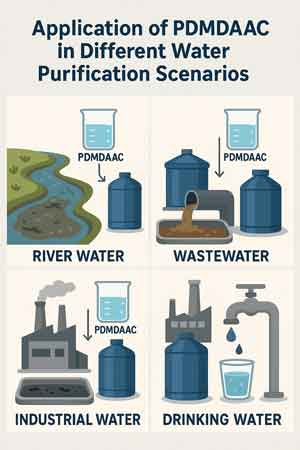Application of Polydadmac in Different Water Purification Scenarios
Poly(diallyldimethylammonium chloride) (Polydadmac), relying on its unique mechanism of action, has demonstrated extensive and effective application value in various scenarios such as drinking water purification, industrial wastewater treatment, and the restoration of landscape and aquaculture water bodies. It can exert targeted purification effects according to the pollution characteristics of different water bodies, solving various water pollution problems.

I. Drinking Water Purification: Focusing on Pretreatment and Advanced Treatment to Enhance Safety Assurance
In the process of drinking water purification, Polydadmac is mainly applied in two key stages: pretreatment and advanced treatment, which are respectively responsible for the important tasks of removing water turbidity and controlling organic matter content.
The traditional drinking water purification process follows the sequence of "coagulation - sedimentation - filtration - disinfection", and polyaluminum chloride (PAC) is commonly used as a flocculant. However, PAC has obvious shortcomings: on the one hand, its effect on removing organic pollutants is limited; on the other hand, it may lead to residual aluminum ions, posing potential health risks.
When a certain water plant treated reservoir water with high humus content, it adopted the "PAC + Polydadmac" composite flocculation system and achieved remarkable results: compared with the single use of PAC, the turbidity of the effluent was reduced by 30%, the removal rate of organic matter was increased by 25%, and the content of disinfection by - products in the final effluent fully complied with national standards, providing a strong guarantee for drinking water safety.
II. Industrial Wastewater Treatment: Targeting Complex Components to Achieve Targeted Purification and Resource Recycling
Industrial wastewater generally has the characteristics of complex composition, high pollutant concentration, and high treatment difficulty. However, Polydadmac can solve pollution problems in a targeted manner according to the characteristics of different types of industrial wastewater, and can also realize resource recycling in some scenarios.
1. Papermaking Wastewater Treatment
Papermaking wastewater contains a large number of difficult - to - treat organic pollutants such as fiber suspended solids and lignin. Polydadmac can effectively remove fiber particles in water through flocculation, and at the same time adsorb organic substances such as lignin by virtue of its adsorption performance. This process not only reduces the turbidity and chemical oxygen demand (COD) of the wastewater, but also recovers part of the fiber resources, realizing the recycling of resources and reducing the resource consumption and pollution discharge of the papermaking industry.
2. Oilfield Wastewater Treatment
Oilfield wastewater contains crude oil, suspended solids, and a variety of chemical additives, making its treatment relatively difficult. By utilizing its cationic properties, Polydadmac can effectively adsorb crude oil particles and negatively charged additive molecules, promoting the formation of stable flocs. After these flocs are removed by air flotation or sedimentation processes, the treated wastewater can meet the standards for reinjection into the formation, realizing the resource utilization of oilfield wastewater and reducing the dependence of oilfield production on fresh water resources.
3. Treatment of Other Industrial Wastewaters
Polydadmac also plays an important role in the treatment of food processing wastewater and pharmaceutical wastewater. Through the dual effects of flocculation and adsorption, it removes pollutants such as proteins, carbohydrates (in food processing wastewater), and drug residues (in pharmaceutical wastewater) from water, reduces the pollution load of the wastewater, creates favorable conditions for the subsequent biological treatment process, and improves the overall wastewater treatment efficiency and compliance rate.
III. Restoration of Landscape and Aquaculture Water Bodies: Balancing Water Purification and Ecological Improvement
Landscape water bodies (such as park lakes and artificial ponds) and aquaculture water bodies have poor fluidity, which makes pollutants easy to accumulate in the water, leading to problems such as eutrophication and the water turning black and smelly. In the restoration of such water bodies, Polydadmac can play the dual role of purifying water quality and improving the ecology at the same time.
1. Landscape Water Body Restoration
Adding Polydadmac to landscape water bodies can effectively remove algae, suspended impurities, and part of nitrogen and phosphorus nutrients in the water. On the one hand, reducing algae reproduction can inhibit the occurrence of algal blooms and avoid problems such as peculiar smell and blackening of the water caused by the massive growth of algae; on the other hand, removing suspended impurities can improve the transparency of the water, significantly enhance the visual effect of the landscape water body, and improve the quality of the surrounding environment.
When a certain urban park restored an eutrophic lake, it adopted a combined scheme of "regular addition of low - concentration Polydadmac + ecological floating bed technology". After 3 months of restoration, the transparency of the lake water increased from 0.5 meters to 1.2 meters, the algal biomass decreased by 60%, the ecological environment of the water body was significantly improved, and the landscape function and ecological vitality of the lake were restored.
2. Aquaculture Water Body Restoration
In aquaculture water bodies, organic debris such as residual bait and fish feces is easy to accumulate in the water, leading to an increase in the content of harmful substances such as ammonia nitrogen and nitrite. At the same time, the growth of harmful microorganisms will also increase the risk of fish diseases. Polydadmac can effectively remove these organic debris, reduce the content of ammonia nitrogen and nitrite in the water, and improve the water environment.
In addition, Polydadmac also has a mild bactericidal effect. It can not only inhibit the growth of harmful microorganisms, reduce the occurrence of fish diseases, and improve the survival rate of aquaculture, but also does not cause stimulation to aquaculture organisms or damage the original micro - ecological balance of the water body. It provides a stable and healthy water environment for aquaculture and helps the aquaculture industry achieve green and sustainable development.





